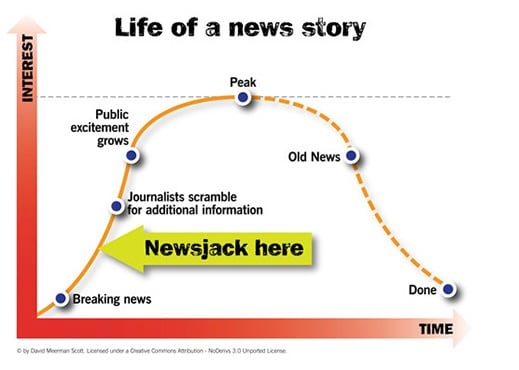How to Make Real-Time Marketing Work for Your Brand
by Jessica Lawlor
Insights / Digital Marketing /

The idea of opportunistic marketing isn’t a secret.
Think about how many football-themed promotions you see leading up to the Super Bowl each year. Consider the number of Election Day deals and trends that emerged out of the 2016 presidential election. Just this past summer, the solar eclipse sparked numerous campaigns driven by brands hoping to latch on to the biggest news of the day.
With the popularity of social media and the widespread use of smartphones, breaking news and trending pop culture stories have become more accessible than ever before, providing the perfect opportunity for brands to use them in their marketing strategies.
Otherwise known as “newsjacking” or “real-time marketing”, capitalizing on a relevant trending topic in your marketing efforts can earn you praise amongst your audience and result in new leads, but only if it’s done right.
Before you jump onto a trending topic, learn more about how newsjacking came onto the scene and check these guidelines to make sure you do it right.
A brief history of newsjacking
Back in 2002, David Meerman Scott was fired from his director of marketing job because his ideas were too radical. He decided to start his own business.
Now, Meerman Scott is a successful author, speaker and the founder of the newsjacking movement which he pioneered in 2011. He defines newsjacking as, “the art and science of injecting your ideas into a breaking news story so you and your ideas get noticed.”
Meerman Scott noticed how quickly news gathering was happening in real time, with journalists scrambling to find unique angles to make their stories stand out among the rest. This, he says, is the place where brands and organizations can make their mark.
Meerman Scott’s theory goes like this: In the first paragraph of a news story, journalists cover the basic facts — the who, what, when, where. But he says the second paragraph needs to explain the why, and that’s where brands can often weave their way into a story.
“If you are clever enough to react to breaking news very quickly, providing credible second-paragraph content in a blog post, tweet, or media alert that features the keyword of the moment, you may be rewarded with a bonanza of media attention,” Meerman Scott says.
Thanks, Oreo
Wondering who to thank for bringing newsjacking into the limelight? That would be Oreo!
Rewind to the 2013 Super Bowl — the power went out, and Oreo quickly tweeted out this gem.
Power out? No problem. pic.twitter.com/dnQ7pOgC
— Oreo Cookie (@Oreo) February 4, 2013
Oreo received widespread recognition for their smart and timely response to a situation at a major event being viewed worldwide.
Sure, Oreo could have bought a Super Bowl commercial placement, but this single tweet gave them all the marketing exposure they could ask for, and had people talking long after the game ended.
The benefits of newsjacking
This newsjacking business sounds a bit tricky, but there are several good reasons to get on board.
- Newsjacking gets your brand or company noticed in a credible and relevant way.
- It’s good for SEO — when you jump on board a trending topic before it’s covered extensively, you have the chance to rise to the top of search results.
- Real-time marketing is often cheaper (and more authentic) than purchasing paid advertising.
- Newsjacking allows you to make a splash, early in the lifecycle of a news story.
Real-time marketing gone bad
Not all newsjacking campaigns are created equal. There are lots of examples of newsjacking gone bad, but here’s one to consider:
Major weather events tend to spark real-time marketing, and not always in a way that’s helpful to consumers trying to ride out a storm. Think back to Hurricane Sandy — this weather event happened in 2012, just around the beginning of the real-time marketing craze.
Consider this example of what not to do: While Hurricane Sandy was wreaking havoc on the northeast, American Apparel attempted to hitch its wagon to the trending news story tweeting, “In case you’re bored during the storm. 20% OFF EVERYTHING FOR NEXT 36 HOURS. Just Enter SANDYSALE at Checkout.”
Yikes. The message was not received well. In fact, the social media universe started the hashtag #SandySaleFail to share their displeasure with the company’s move.
They weren’t the only ones guilty of marketing in poor taste…a dating website asked users to share hurricane-themed date ideas and published them in a blog post.
Three strategic ways to rock real-time marketing
Ready to give newsjacking a try? Follow these three guidelines.
1. Make sure it’s relevant to your brand
It’s not enough to jump on any bandwagon — you need to choose something that integrates well with your brand message and put your company in a positive light amongst your target audience.
For this reason, it’s probably smart to avoid more controversial topics like major weather events, disasters and remembrance days.
While acting quickly (see next tip) is crucial when it comes to real-time marketing, don’t act so fast that you make a big mistake, hooking your brand to a topic you don’t want to be attached to for the long haul.
2. Time it wisely
No one is more unforgiving when it comes to a timing flop than social media users.
It’s important to keep in mind that most cultural fads have a short shelf life. If you wait too long to publish your message following a current event, you risk turning off your audience. Make sure your entire team is on board and ready to churn out your marketing materials quickly if you plan on capitalizing on a current event.
Fun fact: in the Oreo Super Bowl example, the company actually had a social media team together at the ready during the game to take advantage of any opportunities that arose. Talk about forward-thinking!
Remember what Meerman Scott advised above — you want to be included in the second paragraph of a breaking news story. This means you have to be on top of the news and ready to react as soon as something new breaks.
3. Be unique in your approach
As with all great marketing strategies, you need to do something that will help you stand out from your competition.
Marketing around a current event follows the same basic principle. If you’re sharing the same message as everyone else, you’re just creating more noise and reducing your likelihood of being heard.
Remember when Pokemon Go was all the rage back in the summer of 2016? You couldn’t go anywhere without seeing some sort of marketing message tied to the popular mobile app that set a new App Store record, scoring more downloads in its first week than any other app in history.
The problem? Nearly EVERYONE shared the same message, usually something along the lines of, “Hey! Are you playing Pokemon Go? Come play it at our (insert industry category here).”
On the other hand, those that crafted more creative messages that were highly integrated with their brand or product, like this gem from online retailer Amazon, were able to reap the rewards.
While you need to be quick and nimble as a brand to successfully market around current events and trending topics, the creativity of your campaign is key.
Give it a try
Want to incorporate newsjacking into your marketing strategy?
First, start planning now. Take a look at the calendar and see what upcoming major events are around the corner (cough, the Winter Olympics, cough) and see if you can anticipate things that may happen or play out various scenarios now to get ahead for when the time comes.
Second, stay on top of the news. Knowing what’s happening in the world is the only way you’ll be able to jump on a story before it starts trending.
Whether newsjacking excites you or makes you feel anxious (I definitely feel a little bit of both!), there’s no doubt it’s an excellent strategy for furthering your brand message in a creative and smart way.
Have any other tips to add to this list? Tell us your favorite example of real-time marketing. We’d love to hear! Tweet us.
Photo by rawpixel.com on Unsplash





